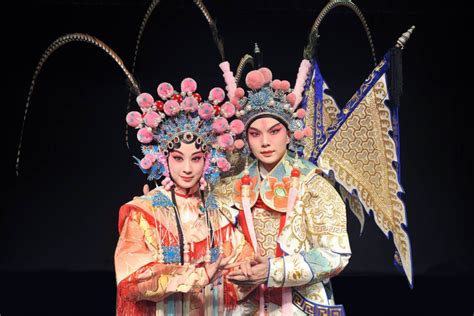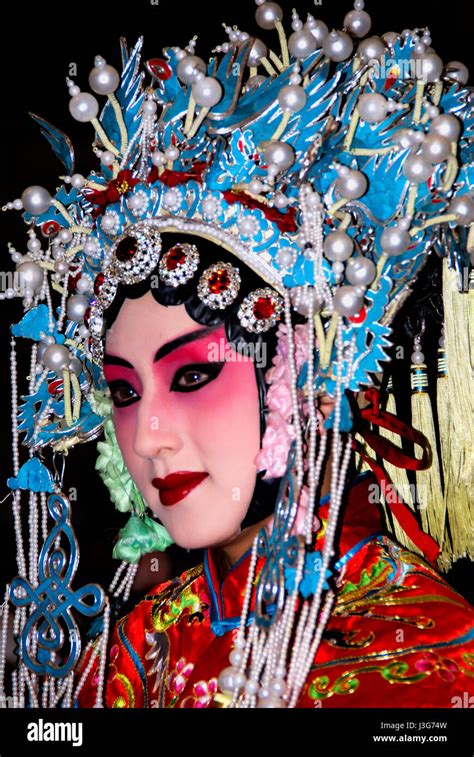Step into a world of vibrant colors, captivating movements, and mesmerizing melodies. Traditional Chinese opera, a treasured cultural heritage, has been enchanting audiences for centuries. From the elaborate costumes and intricate makeup to the graceful gestures and powerful vocals, every aspect of this art form tells a unique story, transporting viewers to a realm where emotions and imagination intertwine.
Embrace the Timeless Elegance
Like a kaleidoscope, Chinese opera is a spectrum of emotions and themes, ranging from tales of love and sacrifice to stories of heroic battles and supernatural encounters. Each performance is a symphony of emotions, blending elements of dance, music, and acting to create a harmonious whole that transcends language barriers. The performers, with their impeccable skills and deep understanding of traditional aesthetics, bring to life characters that resonate with the audience, leaving a lasting impression that lingers in the hearts and minds long after the curtains fall.
Experience the Magnificence of Opera Masks
Unveiling a multitude of emotions, the iconic opera masks play a vital role in Chinese opera. These meticulously crafted masks are not mere accessories but potent tools that portray a character's intentions and emotions. Each color and pattern carries symbolic significance, representing virtues, personalities, and even social status. From the fierce red warlike masks to the delicate white masks of purity, these masks serve as a visual pathway into the psyche of the characters, adding depth to their performances and allowing audiences to connect on a profound emotional level.
Origins and History of Chinese Opera

Discover the captivating origins and rich history of one of China's most renowned performing arts traditions. Immerse yourself in the enthralling world of Chinese Opera, where centuries-old customs and art forms converge to create unforgettable theatrical experiences.
An Ancient Legacy
Chinese Opera dates back thousands of years, with its roots deeply entwined in the country's cultural heritage. This art form has evolved and flourished across dynasties, leaving behind a vibrant tapestry of artistic expression and storytelling.
Synonymous with diversity and creativity, Chinese Opera encompasses a wide range of regional styles, each with its own unique characteristics. From the grandeur of Beijing Opera to the elegance of Cantonese Opera, the versatility of Chinese Opera reflects the rich cultural diversity found throughout the country.
A Spectacle of Tradition and Innovation
Chinese Opera is more than just a form of entertainment; it is a beloved tradition that embodies the values and beliefs of generations past. Every aspect of a Chinese Opera performance, from the meticulously crafted costumes to the intricate movements and gestures of the performers, is steeped in cultural symbolism and meaning.
Yet, even as it stays rooted in tradition, Chinese Opera continues to evolve and embrace modern influences. Innovative staging techniques, elaborate props, and cutting-edge technologies are seamlessly integrated into performances, creating a mesmerizing blend of the traditional and the contemporary.
A Window into Chinese Culture
Exploring the origins and history of Chinese Opera offers a unique glimpse into the customs, beliefs, and historical events that have shaped Chinese society throughout the ages. Through the enchanting world of Chinese Opera, one can gain a deeper understanding of the values, traditions, and artistic expressions that have captivated audiences for centuries.
Join us on a journey through time and immerse yourself in the fascinating origins and history of Chinese Opera, where the ancient and the modern converge to create an unforgettable artistic experience.
Unique Characteristics of Chinese Opera
Discover the remarkable and exclusive features that make Chinese opera a truly captivating art form. This ancient theatrical tradition incorporates a plethora of distinctive elements that set it apart from other forms of performing arts. From its elegant and intricate costumes to its highly stylized movements, Chinese opera encompasses a rich blend of cultural, historical, and artistic elements.
An Elaborate Visual Spectacle
One of the defining characteristics of Chinese opera is its visually stunning presentations. Performers don vibrant and extravagant costumes that are meticulously designed to convey the character's personality, social status, and role within the story. These elaborate costumes, often adorned with intricate embroidery, represent the opulence and grandeur of traditional Chinese attire.
The Art of Facial Makeup
Another unique aspect of Chinese opera is the art of facial makeup, also known as "Lianpu." Actors skillfully apply colorful and detailed masks to depict the emotions and personalities of their characters. Each type of facial makeup carries symbolic significance, with specific patterns and colors representing various character traits such as bravery, loyalty, or treachery. The intricate designs and vivid colors serve to enhance the dramatic impact of the performance.
Gestures and Movements as a Language
In Chinese opera, the performers utilize a highly stylized system of gestures and movements known as "Chou." These movements convey a range of emotions, actions, and even specific objects, such as a sword or a fan. Through these carefully choreographed gestures, the actors communicate with the audience in a language of their own, allowing the story to unfold and emotions to be expressed without the need for spoken words.
A Tapestry of Melodic Tones
The traditional Chinese musical accompaniment, known as "Yueqin," plays a crucial role in Chinese opera. This stringed instrument produces a diverse range of melodic tones that enhance the mood and atmosphere of the performance. The music seamlessly blends with the actors' movements, creating a harmonious fusion of visual and auditory elements that captivate the audience's senses.
The Synthesis of Dance and Martial Arts
Chinese opera incorporates elements of both traditional dance and martial arts, creating a dynamic and energetic performance style. The actors' movements, often characterized by graceful leaps, spins, and acrobatic stunts, bring an air of excitement and athleticism to the stage. This fusion of dance and martial arts not only adds visual splendor but also adds an element of physicality and spectacle to the storytelling.
Experience the mesmerizing world of Chinese opera, where a myriad of unique characteristics come together to create a theatrical experience like no other. Prepare to be enthralled by the extravagant costumes, expressive facial makeup, symbolic gestures, enchanting music, and awe-inspiring martial arts, as they transport you to a realm of ancient traditions and artistic brilliance.
Traditional Costume and Makeup in Chinese Opera

In this section, we will explore the fascinating world of attire and cosmetics in the captivating realm of Chinese opera. Delving into the realm of this ancient art form, we will uncover the intricate details and rich symbolism that lie within the traditional costume and makeup used by performers.
Costume:
The attire worn by Chinese opera actors is a visual feast for the eyes. Elaborate and vibrant, these costumes not only capture the essence of the characters but also serve as a reflection of the historical period and social standing depicted in the performance. Every detail, from the fabric used to the decorative ornaments, holds significance in conveying the personality and role of the character. Various colors, patterns, and accessories are employed to portray emotions, age, and even supernatural attributes of the characters, immersing the audience in a world of emotions and stories.
Makeup:
Makeup in Chinese opera is an art form in itself. Known as "Lianpu," the application of makeup plays a crucial role in bringing the characters to life. Each color and stroke on the actor's face carries deep meaning and symbolism. The makeup not only amplifies facial expressions but also aids in character identification. Different colors represent specific traits, such as red symbolizing loyalty or righteousness, while white reflects deceit or treachery. Furthermore, the intricate patterns and designs are carefully crafted to emphasize the distinctive features and personalities of the characters.
Symbolism:
The traditional costume and makeup in Chinese opera are not solely aesthetic choices. They contain symbolisms deeply rooted in Chinese culture and history. Each element is meticulously selected to represent various characteristics, values, and cultural beliefs. The combination of colors, fabrics, and accessories creates a visual language that enhances the storytelling and helps the audience understand the complexities of the characters and their relationships. It is through these symbolic choices that Chinese opera connects with its audience on a profound level, offering a glimpse into the cultural heritage and traditions of ancient China.
In this section, we have explored the mesmerizing world of traditional costume and makeup in Chinese opera. From the intricately designed costumes to the symbolism embodied in every stroke of makeup, these elements play a vital role in creating a visually stunning and culturally significant performance. By delving into the depths of attire and cosmetics, we have gained a deeper understanding of the rich artistic heritage and storytelling traditions of Chinese opera.
Fascinating Personalities in the World of Chinese Opera
Within the captivating realm of Chinese opera, a multitude of notable and influential individuals have left an indelible mark with their extraordinary talents and captivating performances. These gifted artists have become synonymous with excellence in the craft, redefining the boundaries of traditional Chinese opera and captivating audiences both domestically and abroad.
1. Remarkable Performer: Luo Huilan
- Known for her remarkable vocal range and emotional depth, Luo Huilan has garnered widespread acclaim for her portrayals of tragic heroines.
- Hilan's ability to seamlessly transition between various performance styles, including Peking opera and Kunqu, has cemented her status as a versatile artist.
- Her spellbinding presence on stage consistently mesmerizes audiences and showcases the true essence of Chinese opera.
2. Exquisite Virtuoso: Mei Lanfang
- Mei Lanfang is a legendary figure in the world of Chinese opera, renowned for his exceptional skills in the art of 'Dan' roles, which encompass female characters.
- His graceful movements, melodious voice, and impeccable makeup techniques have set the standard for generations of aspiring performers.
- Lanfang's ability to evoke profound emotions through his performances has been hailed as a true testament to the transformative power of Chinese opera.
3. Visionary Talent: Shang Changrong
- Shang Changrong is recognized as a visionary talent, credited with revolutionizing the portrayal of male characters in Chinese opera with his innovative interpretations.
- His unique approach blends traditional techniques with contemporary influences, resulting in performances that are both captivating and thought-provoking.
- Changrong's commitment to pushing boundaries and exploring new artistic horizons has earned him immense admiration and accolades.
4. Rising Star: Li Yugang
- Li Yugang represents a new generation of Chinese opera performers who bring a fresh perspective and contemporary flair to the age-old art form.
- His eclectic style combines elements of Peking opera, pop music, and fashion, captivating young audiences and breathing new life into the genre.
- Yugang's ability to bridge the gap between tradition and modernity has made him a beloved figure in both mainstream and opera circles.
These are just a few of the exceptional Chinese opera performers who continue to captivate and inspire audiences with their extraordinary talents. Their dedication, passion, and commitment to their craft have elevated Chinese opera to new heights, ensuring its enduring legacy in the world of performing arts.
Challenges and Resurgence in the Modern Era

Uncovering the Evolving Landscape of Traditional Chinese Operas
The panorama of contemporary challenges and revival surrounding the traditional art form of Chinese opera offers a fascinating glimpse into the ever-changing world of performing arts. As society embraces modernity, Chinese opera confronts its own set of obstacles and navigates through the complexities of preserving cultural heritage while adapting to the tastes and interests of a contemporary audience. This section aims to unravel the transformative journey of Chinese opera, shedding light on the challenges it faces and the innovative ways in which it strives for revival.
Preserving Cultural Legacies through Creativity and Adaptation
In an era marked by rapid globalization and cultural fusion, Chinese opera confronts the need to reinvent itself to remain relevant and compelling. This art form, steeped in deep-rooted traditions, faces the challenge of captivating younger generations who may be more drawn to modern entertainment forms. However, instead of forsaking its heritage, Chinese opera has embarked on a creative journey, exploring innovative adaptations to bridge the gap between tradition and modernity. Through experimentation with contemporary themes, technology integration, and cross-cultural collaborations, Chinese opera strives to breathe new life into its performances while retaining the aesthetic essence that has enchanted audiences for centuries.
Rekindling Interest and Engaging New Audiences
Revitalizing Chinese opera entails enticing new audiences to experience and appreciate its unique artistry. The art form's traditional stylized gestures, elaborate costumes, and melodious tunes can at times seem distant and foreign to those unfamiliar with its intricacies. Therefore, efforts to make Chinese opera more accessible and relatable have become paramount in ensuring its survival. With the aid of outreach programs, educational initiatives, and digital media platforms, Chinese opera seeks to tap into the curiosity of younger generations, enabling them to discover the enchantment inherent in its performances. By demystifying its conventions and conveying its cultural significance, Chinese opera aims to broaden its reach and cultivate a new generation of aficionados.
Preserving Intangible Cultural Heritage in the Digital Age
In an ever-evolving digital landscape, the preservation and documentation of intangible cultural heritage have become imperative. Chinese opera, with its rich history and artistic heritage, is no exception. Leveraging technological advancements, Chinese opera strives to safeguard its intangible cultural treasures, allowing them to transcend geographical boundaries and time constraints. By utilizing digital platforms to archive performances, disseminate knowledge, and share experiences, Chinese opera aims to create a virtual repository where enthusiasts and researchers can delve into its captivating world, ensuring that its legacy endures for generations to come.
FAQ
What is Chinese opera?
Chinese opera is a traditional form of theatrical performance that combines music, singing, dance, and acrobatics. It has a long history and is deeply rooted in Chinese culture.
What are the main characteristics of Chinese opera?
Chinese opera is characterized by its elaborate costumes, colorful makeup, intricate gestures, and unique vocal techniques. It also often includes elements of martial arts and acrobatics.
How is Chinese opera different from Western opera?
While both Chinese and Western opera involve singing and theatrical performances, they have distinct differences. Chinese opera focuses more on visual elements such as costumes and makeup, while Western opera emphasizes vocal abilities and storytelling through music.



